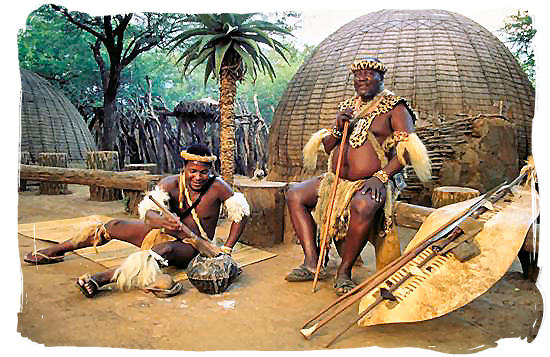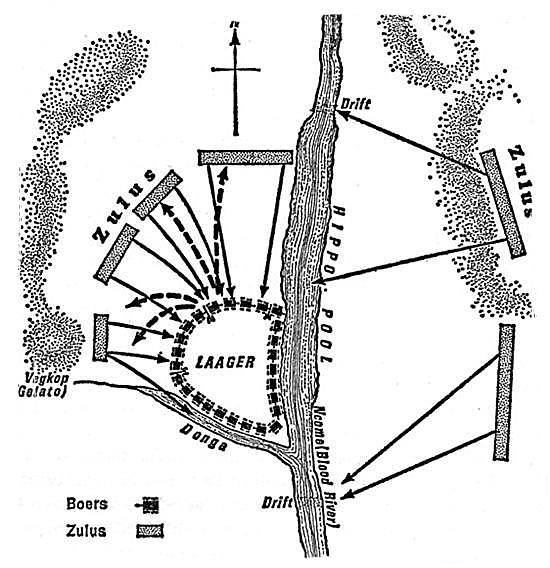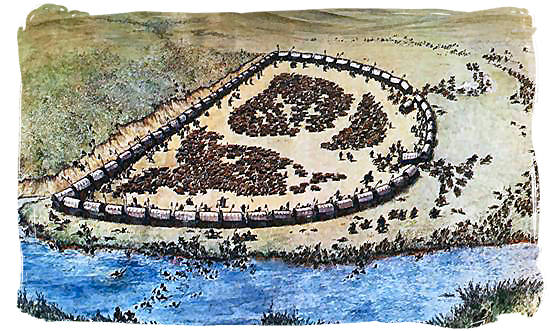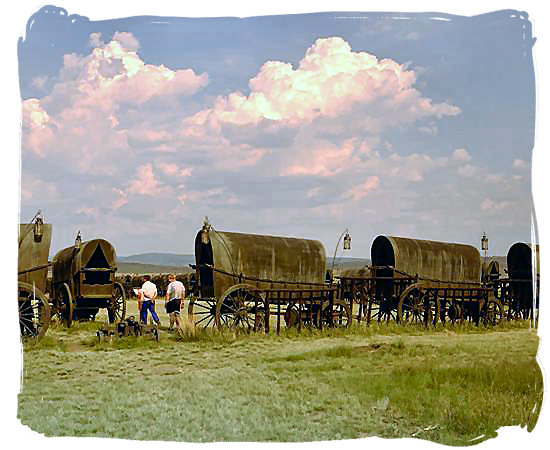-
You are here:
Home
›
-
History of South Africa
›
-
The battle of Blood River
The bloody Battle of Blood River and
the Voortrekker-Zulu war
The battle of Blood River was one of the great
tragedies in the history of the many Voortrekkers leaving the Cape colony, to move to the Natal
region on the eastern coast of South Africa.
At that time Natal was largely inhabited by the Zulus, who had developed into one of the
strongest and most powerful black nations of Africa.
So the land in Natal was not for the taking. And the Voortrekkers had to negotiate with King
Dingane of the Zulu nation, to buy land from them.
He promised them land between the Tugela river and the Umzimvubu river in the south of Zululand.
Having left the Cape on March 1837, Voortrekker leader Piet Retief and his party of about 400
Voortrekkers opted for natal as their destination.
They initiated negotiations with reigning Zulu king Dingane, to obtain land. Dingane promised
that he was willing to cede to the Voortrekkers the land between the Tugela river and the Umzimvubu
river in the south of Zululand.
In return Dingane wanted the Voortrekkers to recover andreturn cattle, horses and a few rifles
that were stolen by renegade chief Sikyonela.

Sketch of a Voortrekker with his wagon encampment in the background
The The Bloody Battle of Blood River
Piet Retief agreed and sent messengers ahead to bring the Voortrekkers the good news. Upon his return they
were already crossing the Drakensberg mountains into Zululand. With the land deal concluded, Retief was able
to convince Voortrekker leaders Gerrit Maritz and Andries Potgieter and their groups of Voortrekkers to join
him.
A month later Retief visited Chief Sikyonela and recovered Dingane’s cattle, horses and guns, taking more
then was stolen as a fine. He was now ready to finalize the land deal with Dingane. Retief was warned however
not to go Dingane’s kraal, because of the King’s penchant for treachery, but he felt that the final
conclusion of the transaction agreement with Dingane was too important.

Zulu Induna (chief) with his weapons and shield at the Shakaland Zulu cultural village
The The Bloody Battle of Blood River - copyright © South African tourism
In the last week of January 1838, accompanied by a party of about of 69 Voortrekkers, Retief started the
journey with the recovered cattle and horses to Umgungundlovu to visit Dingane for the second time. Meanwhile
Dingane had learnt that Retief had taken more cattle and horses from Sikyonela then what needed to be
recovered, with the intention to keep those for himself, that the Voortrekkers already had entered Natal in
large numbers, and that Andries Potgieter and his Voortrekkers with their powerful guns had defeated the
Matabele people.
The seeds of perfidy had been sown. Having arrived at Umgungundlovu, the King kept Retief and his company
waiting for several days, entertaining them with displays of dancing and mock battles. Even though he had
already decided to have them all killed, Dingane signed the treaty ceding the land to the Voortrekkers.
The next day, the 6th of February 1838, Retief and his men were invited to a farewell celebration at
Dingane's kraal. To show their respect, they were asked not to bring their weapons. At the height of the
celebrations, consisting mainly of dance performances by Zulu warriors, Dingane leapt up and shouted
"Bamabani abathakathli!" (Kill the wizards). Retief and everybody with him were overpowered and executed
KwaMatiwane hill, Retief being the last one to die.

Sketch of the Zulu king Dingane chanting over the dead body of Piet Retief
The The Bloody Battle of Blood River - copyright © South African tourism
Dingane’s next step was to try and exterminate all the Voortrekkers that had entered his territory, sending
his 15,000 men army to attack the dispersed Voortrekker Laagers (encampments). Unsuspecting the Voortrekkers
were encamped at the foot of the Drakensberg mountains, expecting good news from Retief’s meeting with
Dingane.
To them the Zulu attack came as a total surprise. Their laagers were completely wiped out at Weenen,
Bloukrans and Moordplaats, with hundreds of men, women and children killed. Some of the laagers further away
were warned in time of the coming attack and they had been able to repulse some of the attacks.
Licking their wounds and shocked close to despair, the Voortrekkers in their anguish to survive and seeking
revenge, saw attack as the only way of defence. On 5 April 1838 a force under commandant Dirk Uys rode out
towards Umgungundlovu, followed by Andries Potgieter and his men. At Ithaleni near the Zulu capital, they
ran into a Zulu ambush. Commandant Uys and many of his men were killed, while the survivors were scattered
and driven off.

Young Zulus performing a warrior dance
The The Bloody Battle of Blood River - copyright © South African tourism
For the Voortrekkers this was almost the last straw and their spirits were at their lowest ebb. On the 12th
of August 1838 they were attacked again by the Zulus at “Veglaer”. This attack lasted a full three days and
nights. But this time the tide was to turn in favour of the Voortrekkers. Making their last stand last,
the Voortrekkers were able to repulse attack after attack.
Finally, at the end of the third day, the Zulus called off the attack and disappeared, leaving hundreds of
dead warriors behind. Only one Voortrekker lost his life. This proved to be the turning point. Although the
death of their leader Gerrit Maritz after a long illness was a further set-back, things started to improve.
A much needed new strong leader was found in the person of Andries Pretorius, who arrived in natal on the
22nd of November 1838. He lost no time in getting things back on track under the Voortrekkers. Together
with a force of almost 500 men and over 60 wagons loaded with provisions and gunpowder, he moved into
Zululand to seek vengeance.

Portrait of Andries Pretorius, leader of the Voortrekkers in the Battle of Blood River
The The Bloody Battle of Blood River
With the simple strategy of marching straight to the Zulu capital Umgungundlovu and destroying the enemy
when encountered, with the odds stacked against them, they realized that they needed the help from above. On
the 9th of December they made a vow to God, that if God granted them victory, they would forever honour Him
by observing that day as a Sabbath and by building a church as a memorial for future generations. They
were to repeat this vow every night until they encountered then Zulus.
Upon receiving reports that the Zulu army was on its way to meet them, the Voortrekkers looked for a strong
position to form their Laager (encampment) and make their stand. Having reached the banks of the Ncome river
on 15 December, Pretorius choose a position with the Ncome river protecting the laager from the east and a
fairly deep donga (ravine) protecting it from the south. This would force the Zulus to attack across open
plain terrain from the north and the west.

Map of Voortrekker and Zulu positions during the Battle of blood River
Because of misty conditions on the evening and night of the 15th of December and having misjudged the
distance to the Voortrekker Laager, only about half of the 15,000 men strong Zulu army had been able to
cross the Ncome river and reach their attacking positions.
Instead of waiting until the rest of the army had crossed the river, they attacked at dawn of the morning of
the 16th December 1838. This proved to be a fatal mistake. With their guns and two canons proving to be
the equalizing factor, the Voortrekkers were able to repulse them charge after charge, while the Zulus that
were still trying to cross the river, were cut down easily.
Running out of ammunition at the end of the day Pretorius chanced a desperate charge on horseback by 300
men, splitting the Zulu army. By this time the Ncome river was coloured red from Zulu blood (hence the name
Blood River) and over 3000 Zulu warriors had already died. Not a single Voortrekker was killed. At nightfall
the Zulus gave up and retreated and so the battle of Blood River came to an end.

Sketch of the Battle of Blood river
Four days after the battle of Blood River, Andries Pretorius and his victorious Voortrekkers reached the
Zulu capital Umgungundlovu on the 20th of December 1838, finding it deserted and completely burnt down. On
KwaMatiwane hill they found the remains of Piet Retief and his party.
Surprisingly enough, the satchel with the treaty ceding the land to the Voortrekkers, was still intact on
Retief’s body. Chased by the Voortrekkers and his revolting half-brother Mpande, Dingane fled to Swaziland
where he was later killed by local chiefs and his own Indunas.

Blood River monument, a replica of the fortified Voortrekker Laager on the site of the Battle of Blood River
copyright © South African tourism
Keeping their Vow, the Voortrekkers built a memorial church in Pietermaritzburg (named after their leaders
Piet Retief and Gerrit Maritz) two years later. In commemoration, the 16th of December was known and
celebrated as "Dingane's day" until 1910.
Thereafter it was renamed "Day of the Vow" and recognized as a public holiday by the first South African
government. With the end of apartheid in 1994, the day was kept as a public holiday in a conciliatory gesture
to the "Afrikaner" population, but renamed "Day of Reconciliation".
Top of Page
-
Home
›
-
History of South Africa
›
-
The battle of Blood River

